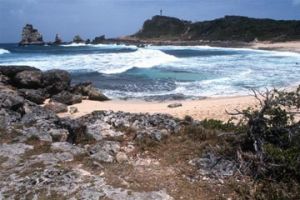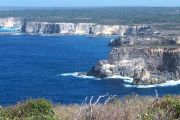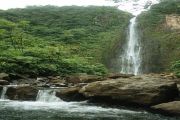 |
 |
Swimming and adventures in Guadeloupe |
 |
 |

|
 Pointe des châteaux © T.Joly Pointe des châteaux © T.Joly

|
In Guadeloupe beaches and bathing go hand in hand with adventure and tropical forests. In this multi-faceted island in the Antilles winter takes place beneath sunny skies and with one’s feet in the sea.
[ Practical ]
- Getting there
Daily flights with Air France, Air Caraïbes and Corsairfly. Flying time: 8 hours.
- Time difference
5 hours in winter, 6 hours in summer
- Lodging
Gosier : Créole Beach, Sofitel Auberge de la Vieille Tour
Sainte-Anne et Saint François : Club Med, Toubana, Eden Palm, Village Pierre et Vacances, Anchorage Anse des Rochers
Basse Terre : Villas Aquarelles, Jardin Malanga
- Cuisine
Guadaloupean cuisine is a mix of European, African and Indian influences. It can be very spicy. The international hotels also serve European dishes.
- Getting around
Hiring a car is the best way to discover the island. Buses are slow and have irregular timetables.
- Good to know
Travel agents offer half-board, full-board and all inclusive packages. Half-board is the best option for those who plan to make trips around the island.
The roads are well maintained and the distances short. As in France, watch your speed.
Be careful after dark in certain neighbourhoods of Pointe-à-Pitre.
- Tour operators
Austral Lagons, Club Med, Des Hôtels et des Iles, Exotismes, Fram, Jet Tours, Kuoni, Look Voyages, Nouvelles-Frontières, Pierre et Vacances, Thomas Cook, Tourinter, TUI.
Prices can vary greatly from one hotel to another and depending on the season. A week’s stay in a double room with breakfast from 720 € per person including flights between may and November, from 950 € - 1 000 € between December and april
- Information
Comité du Tourisme des Iles de Guadeloupe, tel : 01 40 62 99 07
www.lesilesdeguadeloupe.com
Now that winter is underway what could be more appealing than the lure of sun, white sandy beaches and bathing in a hot sea ? All of these pleasures are to be had in Guadeloupe between December and May when the Antilles enjoy their dry season. Moreover, being part of France, it is one of the départements d’Outre Mer, Guadeloupe is extremely easy to get to, with numerous flights a day making the 8 hours trip.
 Siesta or water sports Siesta or water sports
Nicknamed “The Butterfly Island” because of its shape, Guadeloupe is much more than just a beach destination. Rocky mountains and tropical forests also make it a prime spot for hiking, mountain biking and canyoning. A large range of activities split between the island’s two districts, Basse-Terre and Grande-Terre. To the east, Grande Terre has an abundance of white sandy beaches lapped by crystal clear waters. Understandably, this is where most of the large hotels can be found, starting just a few kilometres from the airport on the outskirts of the island’s principal town, Pointe-à-Pitre. In Bas du Fort, near the marina were the competitors in the Route du Rhum meet every four years. In Gosier, the most important beach resort in Guadeloupe. This is an ideal central location for exploring the island, and its beaches, although small, are full of charm. Moreover, there are bars, restaurants and discos all in the immediate vicinity. The downside of this heavy development means that apart from the hotel parks there is not much to tempt you in the way of countryside.

 Pointe de la Vigie © T.Joly Pointe de la Vigie © T.Joly
|
 Beaches and cliffs Beaches and cliffs
For a more rural atmosphere all you need to do is travel 20 kilometres to Saint Anne and, beyond that, Saint François. It is here that the longest beaches can be found. As everywhere on the island the big choice is: sunbathing or water sports ? Jet ski, catamaran, windsurfing, water skiing, scuba diving but also more unusual offerings like the vast mangrove swamp near Vieux-Bourg and Pointe-à-Pitre, which can be explored by boat, jet ski or sea kayak. Or the Pointe des Châteaux, near Saint-François, where ragged rocks forma a dramatic and wild landscape. To the north, 30 to 80 metre cliffs stretch along the coastline from the point of Petit Nègre to that of Grande Vigie; an 11-kilometre path, known as the Sentier des Douaniers, skirts the top of these cliffs taking you past the idyllic lagoon known as the Trou de l’Enfer (or Hell Hole!).
 Rum cocktails Rum cocktails
By comparison, the interior of the island is flat and monotonous apart from the Grands Fonds (or “Great Depths”), a labyrinth of small, steep valleys where the traditional mode of life on the island can still be found, even if urbanization is making inroads. The surrounding plains can be explored on horseback, ox cart or quad bike. Here prairies give way to fallow pastures, fields of vegetables and above all sugar cane. The importance of this crop in days gone by can be seen in the ruined mills where the cane was crushed and in the museum installed in the old Beaufort sugar factory. There is only one sugar plant still operative on the island; the rum distilleries however are doing fine! Indeed, it is impossible t imagine life on Guadeloupe without Ti Punch, the local cocktail made of a mix of rum, cane sugar syrup and lime.
 A night in the jungle A night in the jungle
In Basse-Terre the landscape changes completely. Despite what its name (“Low Land”) might suggest this part of the island is actually much more mountainous. The highest point is the active volcano of Souffrière, 1467 metres, whose summit is shrouded in smoke and sulphur. However it is hard to get a sight of “the Old Lady” as it is known to the locals since it, like the neighbouring peaks, is often covered by clouds. These clouds mean rain which in turn means luxuriant vegetation and numerous rivers and spectacular waterfalls like those of Carbet and Moreau. It is for this reason that the Amerindians called Guadeloupe “the island of the beautiful waters”. It is this people, now vanished, who left the mysterious rock carvings in the archeological park at Trois-Rivières. Protected by a 10,000 ha natural park, this tropical ecosystem is criss-crossed by a multitude of paths which allow you to explore it, on foot or on bike, for a few hours or a few days. Nights are spent in bivouacs in the midst of frangipanis, tree ferns and orchids.

 Carbet waterfall © T.Joly Carbet waterfall © T.Joly
|
 Diving on a reef Diving on a reef
And in all safety too since there are neither poisonous snakes or malaria on Guadeloupe. Those who wish can also explore the forest by moving from tree to tree thanks to specially constructed paths or else can follow the waterways: a practice known as canyoning. The coastline here is not dominated by long beaches but rather by small bays, a coral reef with great diving spots and traditional villages of coloured houses. There are no tourist complexes either, just charming hotels by the sea or on the heights set in the forest or on coffee, banana and vanilla plantations. The main town here, also called Basse-Terre, has kept a provincial feel with its morning market and colonial houses. A far cry from the hustle and bustle of Pointe-à-Pitre, the prefecture, strategically situated at the junction between Grande-Terre and Basse-Terre. Two museums here attract lovers of literature and history: one is dedicated to the poet, Saint-John Perse, who won the Nobel Prize for Literature in 1960; the other to Victor Schoelcher and his battle against slavery which he helped to have abolished in 1848. The darkest chapter in the island’s history.
December 17, 2017
Thierry Joly 

|
|
 |

|
 |



